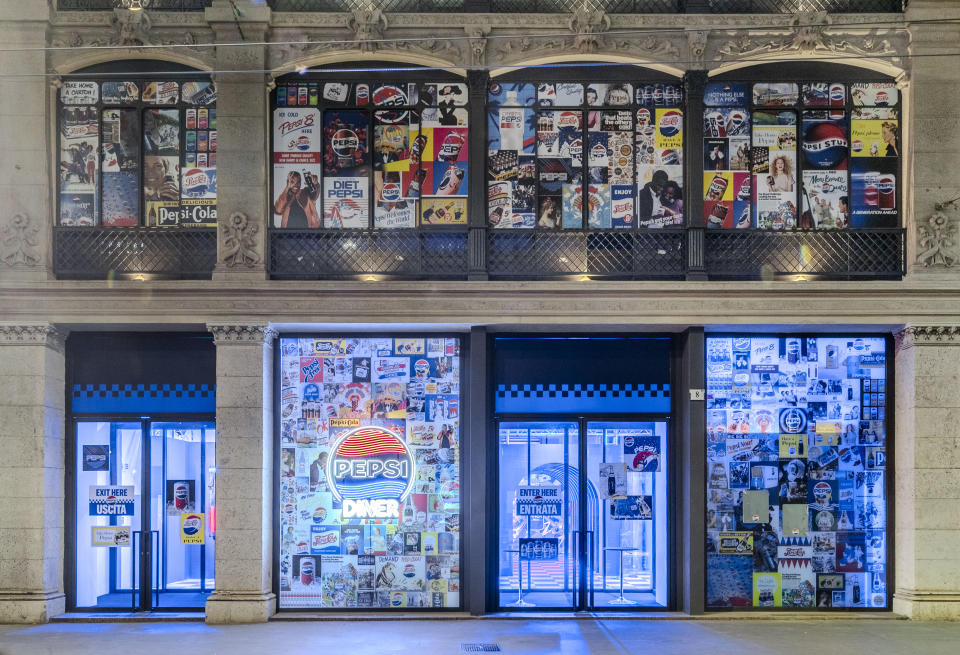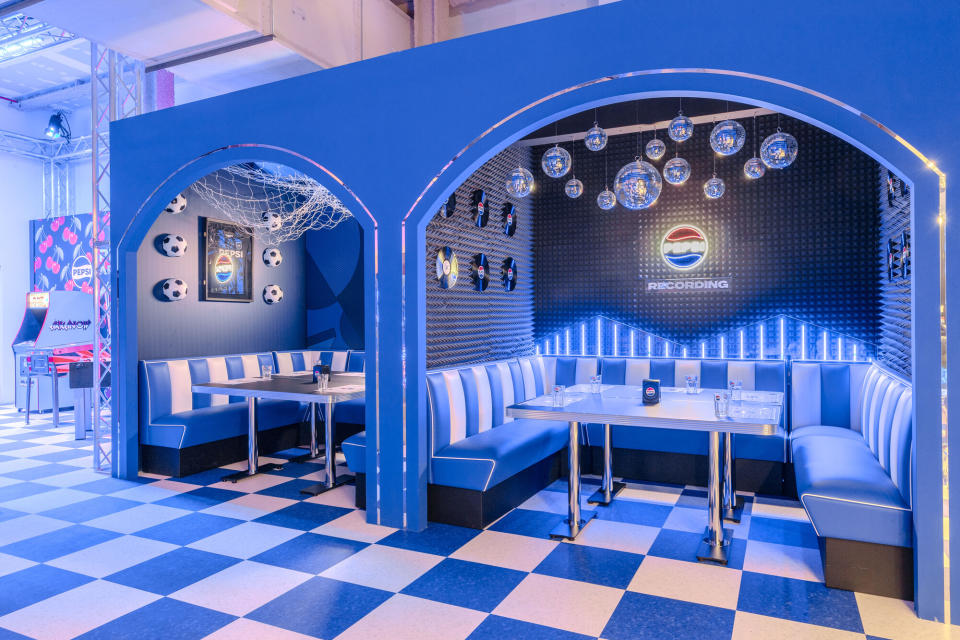Meet the Creative Force Behind Pepsi’s 125th Anniversary Diner and New Logo

MILAN — Mauro Porcini is currently in Maui, wondering if it’s possible to find decent pasta. Indeed, he’s about as Italian as they come, working for one of the most American companies on the planet.
As chief design officer for PepsiCo, a role created especially for him 12 years ago, Porcini has been particularly busy this year. He famously altered the Pepsi logo, changed the iconic Pepsi blue into a blend of black and blue, and is currently overseeing the creative side of a global rollout of the beverage maker’s 125th anniversary celebrations.
More from WWD
An all-American diner, which has already opened its doors in New York City, was feted in Milan on Thursday in via Tommaso Grossi 8. Inside, guests were welcomed by the play of neon lights and an electric blue and white checkered floor. Upon entering, vintage logos and graphics took visitors on a journey through Pepsi’s rich history. The space was outfitted with a tunnel that serves as a symbol of the beginning of a new era, opening up to the actual diner furnished with sports-themed booths and an arcade and where themed music sets the mood.

The temporary restaurant will remain open until June 10 and will celebrate the new look and the company’s updated logo — the 14th time it has been changed since the soda was invented in 1898 by pharmacist Caleb Bradham, who renamed his famous soft drink Pepsi-Cola.
Here Porcini, who is also the author of “The Human Side of Innovation: The Power of People in Love with People” and president of the Polytechnic of Milan Fellows, talks with WWD about how an Italian design philosophy vibes with PepsiCo.
WWD: Do you think there is a link between design and beverage and spirits in the United States, as seen in Italy, where the creative design behind heritage brands like Campari fed the contemporary design movement?
Mauro Porcini: There is for sure because just looking at the history of design of Pepsi and other beverage brands in our category, you see the types of different designers over the course of history, but it’s a different one. And the big difference between American design and Italian design in Italy is that in Italy, there is more craft and it has always been about the emotional and intellectual relationship between a creative and an entrepreneur. This is true in food and beverage, but it’s also true in fashion, product design, furniture and lighting. At the same time, American design is more strategic and influences the global market. Both visions are relevant; they have different highlights and each vision completes the other one.
WWD: Is there a real push to promote Pepsi in Italy?
M.P.: Oh yeah. For example, there are countries in the Middle East where we are really strong. You know, we have a huge market share… And I think this new identity, this new push for this bold kind of language, the connection with Champions League and with the world of sports and music, for sure will help the growth of the brand. And for sure there is appetite for growing the brand in Italy.
WWD: Let’s talk about the reasoning behind your re-design of the Pepsi logo. Why black?
M.P. In the new logo, there is this blending of black and blue together. Pepsi has been blue for many years. And, in the past, there was always this position between blue of Pepsi and red of Coke. One of the key drivers of this redesign of Pepsi is this new big focus on zero sugar, and zero sugar in our industry is black. And so we were faced with this challenge of how to manage a brand that was blue with this new need to really focus on black and this intention and this strategy of using black zero sugar as the main dominant character of all communication.
WWD: When you worked on the Super Bowl halftime show, how closely did you work with superstars like Bruno Mars and Snoop Dog, for example?
M.P.: We were the ones building the assets for communication and amplifying the event through our channels. We worked with the performers on the integration of the brand and the performance. So there was a mix between what the artist could do… you know, the artist is totally free to do whatever they want, but we briefed them, we followed them and we worked with them and we amplified all of it through communication.
WWD: How does Pepsi transcend its reach into other creative fields like fashion?
M.P.: There is always that impact with very visible experiences and activations as well as with the less visible ones. You mention fashion… we are working on different collaborations in the world of fashion.
Collaborations between Pepsi and Dsquared2 or Pepsi and Puma or assets used by Dolce & Gabbana, all the way to Pepsi shirts by Zara or H&M… that’s what Pepsi is about. It’s a totally transversal brand, consumed by billionaires and by the masses alike, with the same level of joy. And so this is how Pepsi has been part of culture with this mindset that today we’ve translated in “a thirsty for more” or, you know, enjoying the moment and trying to do more and really push the boundaries.
WWD: Are you the first non-American to hold your position as chief design officer at PepsiCo?
M.P.: I’m the first ever to have the position. The position was created for me. Let’s say that it is not usual for Italians to have this kind of position in design in American corporations. And I think one of the issues is this cultural difference between Italy and the United States.
In Italy, the designer is used to interacting with another human being, the visionary entrepreneur and eventually with a third actor, the technologist, the artisan or the manufacturer, the ones that make the dream come true. Together they imagine the future and create amazing solutions for people. In America instead, as a designer leader, you need to be able to also speak the language of business and processes, interacting often with dozens of stakeholders, moving verifiably complex organizations with the power of imagination mixed with numbers.
WWD: How did you get your start in design?
M.P.: I did my thesis in Polytechnic of Milan in wearable technologies with Philips and it was a project where the world of tech met fashion. And so my very first job was working in Philips, working on wearable technologies and the life of the future in 1999 and a few months in 2000.
This was far before anyone started talking about wearable technology. Philips started to work on those technologies in those years; it was very early and technology was not ready for something like this.
WWD: In your early years you created your own company working in digital technologies, the internet and then the world of music and celebrities with showbiz producer and music artist Claudio Cecchetto and later went to 3M for 10 years, where you left as chief design officer and have been at PepsiCo for 12. What are some surprising aspects of your job at PepsiCo?
M.P.: When I joined PepsiCo, I never would have thought that I could have started to work again on wearable technologies. And instead, one of our most successful projects in the past few years has been Gatorade GX.
Particularly the system where you have these wearable technologies and you put these patches on your skin. The patch monitors your perspiration levels, composition and then sends that information to an app that communicates to the wearer what kind of Gatorade one needs on the basis of the body’s perspiration.
WWD: Do you remember when Pepsi became popular in Italy?
M.P.: When I was about 6, 7 years old, I used these Pepsi notebooks for mathematics, geography, biology.
I still have them today… it’s an amazing coincidence. In the early ’80s, it was already a relevant brand in the country and for sure, many years before that.
WWD: How did you make the Pepsi Diner something that would resonate in a place like Milan?
M.P.: Well, the secret of success of global brands like Pepsi is its ability to connect the brand in an authentic way… the heritage of the brand, the nature of the brand. And in this specific case, in the case of Pepsi, one could say it’s an American brand with local culture. We call this approach “glocal,” being able to understand how to be globally strategic, globally authentic, but then also making sense in the different parts of the world where we are.
WWD: Pepsi campaigns have had the power, over the years, to uplift society, even amid difficult times. Is there anything emotional in all of these 125th anniversary campaigns and activations that have had similar power in assuaging suffering impacting the entire globe?
M.P.: Every brand has its own role. Pepsi’s is to be lighthearted and it’s all about this idea of being “thirsty for more.” In the past, it was this idea of live for now… [as if to say], “I’m enjoying the moment, but with purpose… I’m trying to do something that gives me excitement, that gives me a drive towards the future.”
And so it is important that Pepsi plays that kind of role. We offer a moment of distraction from what’s going on in the world. The moment brands like Pepsi attempt to dive too deep into social events, it may fire back.
WWD: What is one of the key things you have learned at PepsiCo?
M.P.: I always mention this because we don’t think about this enough… Pepsi was born more than 125 years ago. Nobody that is alive today was born back then. And so when I joined the company 12 years ago, I joined the company with a profound respect for a brand that’s around for a long time, before I was even born. And for sure, it will will be there for many years after I will be gone from this planet. And so my role, the role of my team and the people surrounding me in the company is really one of nurturing the brand in this small phase, in a big, long history.
And we’re just, you know, small actors in this big journey of this iconic, beautiful brand.

Best of WWD


